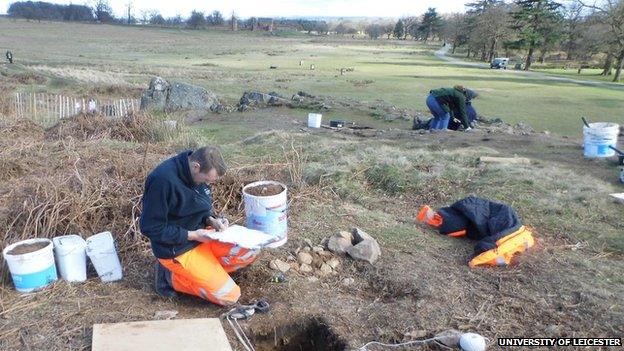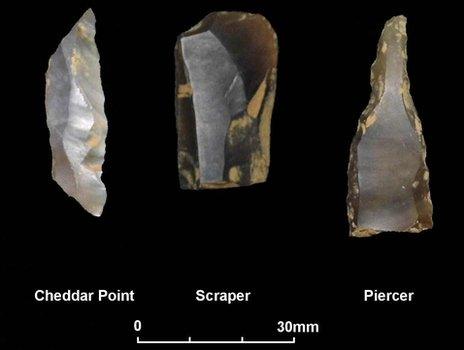Bradgate Park 'was used as Ice Age hunting ground'
- Published

Test pits were excavated at the Creswellian site overlooking the Lin floodplain and Bradgate House
Flint tools found at a public park in Leicestershire indicate it was used as an Ice Age hunting ground, say archaeologists.
The flint artefacts were revealed by the gradual erosion of a footpath at the eastern end of Bradgate Park.
They have now been evaluated to determine who may have been active in the area.
Experts believe the site was used by "hunter-gatherers of a culture termed Creswellian".
The culture is named after Creswell Crags, a limestone gorge with caves once used by ancient ancestors, located on the border of Derbyshire and Nottinghamshire.

The Cheddar points could have been used on wooden spears in this position
The remains were investigated by University of Leicester Archaeological Services (ULAS).
Lynden Cooper, project officer at ULAS, said: "Rapid climate change c15,000 years ago led to large tracts of new grassland territory becoming accessible to animals such as horse, deer and reindeer.
"A small band of humans, late Magdalenian hunters, also entered this new land of plenty, and within a short period of time had evolved into the Creswellian people.
"Innovative stone tool technology can be seen to reflect new hunting strategies required to cope with ecological changes resulting from the warming climate."
The tools include blades known as Cheddar and Creswell points, and scrapers used to process animal hides.

The scraper and piercer were manufactured on longer blades but these have broken through use
The university said that while there are about 20 Creswellian cave sites around the UK, Bradgate Park was a "very rare" discovery of an open air site.
ULAS was assisted by Rob Clough, a ranger at Bradgate Park, as well as Graham and Christine Coombes, who found the first flint pieces in 2001.
The site is thought to have been a hunting stand, where hunters intercepted animals such as horse and deer that were passing through the gorge.
- Published22 March 2011
- Published14 March 2011